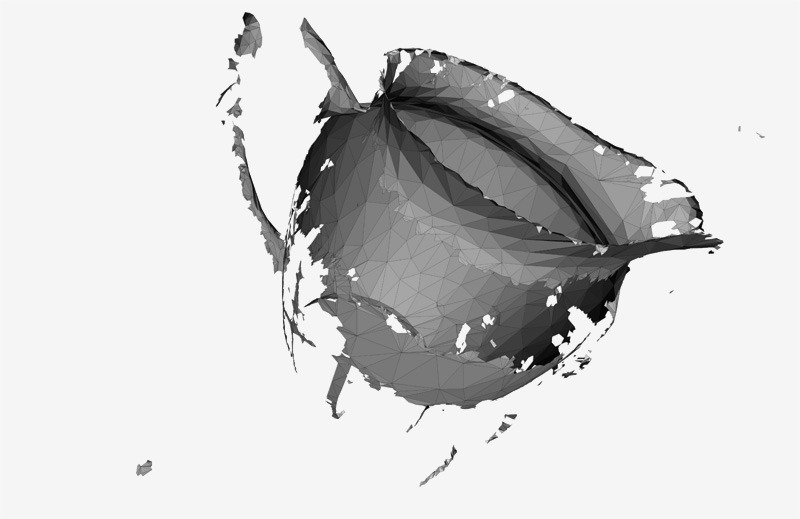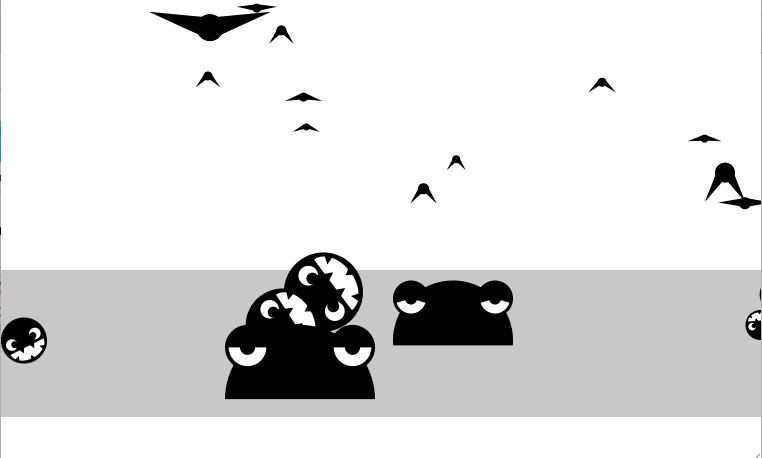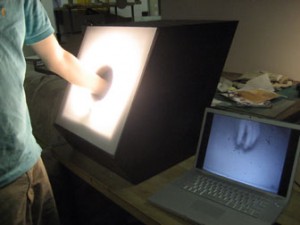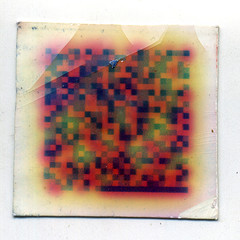These are some project ideas I had for the Twitter and Arduino project:
1. The idea of having something that tweets (twits?) when a sensor is activated doesn’t really appeal to me, however, being able to control something with a tweet does. I would like to build some sort of program that would make it so that people could tweet and control the colors in a RGB led contained in some sort other apparatus. That way people could create specific colors with a tweet.
2. If I was to use some sort of sensor, I would like to use a GPS sensor that would randomly, or at a set interval, tweet my exact GPS coordinates to Twitter. I think this would be interesting since I could then map the information to form a sort of path throughout my day. However, I don’t know if the GPS shield would be needed for this or a sensor (do they make sensors for that?).
3. Finally, I would use a light sensor to tweet everytime I change from a specific area of light to a rather dark area.
Comments Off on Twitter and Arduino
– You could put a tilt sensor on a toilet flusher so it tweeted every time someone went into the bathroom.
-you could have a camera placed somewhere (like a doorway) and every time someone walks through the doorway, their picture is taken and then posted on twitter.
-you could put a gps in your shoe and tweet your location every so often.
-some sort of sensor that detects movement (tilt maybe?) in combination with a lillypad arduino so that every time you got undressed it tweeted.
-Place a radiation sensor in the labs around campus, doherty studios too, and have it tweet every so often
Comments Off on Ideas
Some ideas I thought would make use of Twitter and the Arduino in interesting ways:
1. A device that was attached to your face near your eyes, and could tell when your eyes were closed. I’m not sure exactly how this would work, but it would somehow be able to sense when your eyes were closed, and infer things from this information. It could count the number of times you blink (which might be interesting to compare from day to day), or see if there were certain times when your time of blinking lasted longer than other times. It could also be used to see how long you closed your eyes when falling asleep in class (which would be pretty interesting for me at least). It would also be interesting to see the results for when you were falling asleep at night. Perhaps after a certain amount of time closed, a tweet could be sent saying that you were asleep. Because you can’t really send a tweet once you are asleep, this could be pretty useful (depending on the circumstances).
2. Hooking up a light sensor to something like a phone. This way, you could tell how many times you took the object out of your pocket, and see an overall reading for how long it was being used (perhaps a light senor would not be the best because it isn’t necessarily light outside of your pocket). Perhaps a light sensor could be placed in the inside of wallet to see when it was actually opened. The idea of using sensors to see when something occurs, and for how long, (similar to my idea for #1) is pretty intriguing to me.
3. My last idea is for (the somewhat cliche idea) of some type of sensor to see how someone was feeling. Perhaps reading their pulse somehow, or taking their temperature, or even combining multiple sensor values such as these. I think it would be interesting to be able to see what times of day you were excited, nervous, etc. Trying to remember what was happening at a certain time to make you react in such a way, and the reaction itself, would be pretty cool. I think a tweet alerting people that you were in a stressful situation could be pretty interesting as well. It might be difficult for the sensors to determine what was actually happening to you, but being able to broadcast how you were feeling through values instead of words would be nice.
Comments Off on Twitter And Arduino
1. Twitter seems as though it can be an constant stream of information at times and I would like to make a stream of liquid controlled by pressure either being applied or released by a servo motor. When twitter messages were posted to my accounted the stream of liquid would flow. When there were no tweets, the servo would cut off the water supply. This would be a way of physically measuring the amount of data provided to us in a real-time format.
2. I am interested in having an event triggered when a chosen twitter source posts a tweet and was inspired by Ellie Harrison’s Vending Machine, (./10/11/vending-machine-ellie-harrison_lookingoutwards4/). I primarily follow art institutions on my twitter account and was thinking about triggering an action or projection in response to those particular sources. I am still thinking about exactly what this action or image would be and its significance. Perhaps using the tweets from these sources to generate a drawing or art of my own, creating a somewhat un-known and removed collaboration with these institutions.
3. Following the same thought process described in idea #1, I am considering making a kinetic sculpture, using motors connected to an arduino, that’s movement would be dependent on receiving tweets from a chosen source. Possible ideas to explore are how lines of formality and casualty are treated with online medias. I am also interested by the increased accessibility that twitter provides to a large amount of information in a brief format and feel an action could be created to exemplify this as well.
Comments Off on Ideas for interactive tweet, Sarah Keeling
Idea 1:
Create an automated personal data stream by hooking up a camera that takes and posts a picture every time you blink. This way you are creating almost a constant stop motion of your life and broad casting to all your followers. Posing the question, are you really in charge of your posts and the reputation they create.
Idea 2:
Twitter is a social broadcasting medium through which reputations can be made and ruined. This project would involve translating this power from the screen to a physical object. The participant would log onto their twitter account and then bend a flex sensor attached to an arduino. The further you bend the sensor the more outrageous the lies posted to your twitter account. The lies would be taken from available data on the most commonly held secrets. The information would therefore be generic, yet when associated with your own personal twitter account, embarrassing.
Idea 3:
This idea is similar to the last one, but more specific. They both involve using a physical interface to control a stream of fallacious twitter posts. This project would involve a potentiometer and a stream of political comments . The further to the left you twist it the more left wing the comments are and vice-versa when you twist it to the right.
Comments Off on Tweet tweet :> -Caroline Record
1. I would love to put a sort of pressure sensor in my bed, that would send a tweet whenever i get into or out of bed (to track my lately irregular sleeping patter). It’d also be (so not) cool if an alarm or obnoxious sound would play whenever “Wake Up” or something similar was tweeted to my page if i was in bed (of couse, this wouldn’t be anonymous, so I’d know who to blame).
2. Potentially: Rig a servo to my guitar and have a chord preset so that whenever somebody tweets a certain word, say “Strum,” the chord is played. I’d really like to hook it up so that whatever letter (from A to G) is tweeted, the corresponding note was played, but I’m not sure how viable that is.
3. Hook up a pen to a servo that would take directions from twitter and apply them to the arduino. For example, “up, down, left” could be tweeted, and the servo(s) would move the pen those directions. If paper was placed under the pen, this may lead to some interesting (or really un-interesting) drawings being created. I’d like the rig to be very loose, so that not all the lines would be perfectly straight. Maybe the paper would move too, so the drawing would stretch out to more of an area of the paper.
Comments Off on Twitter + Arduino Ideas! – Eric Mackie
Things I think would be neat to tweet as they happened, using an arduino as a detector of the occurrence:
1. Even though this may seem trivial, I always want to know when people are going to sleep and waking up. If I need to contact someone and it is a questionable hour of the day, ie, sometime in the late hours of the night or early hours of the morning, it would be good to know if I would be waking them up if I called or getting a response to a text anytime in the near future. This would probably work by putting a button or a sensor under their pillow and it sending a tweet when the head hits the pillow.
2. I think it would be really neat to know when someone is thinking about you, or talking about you. One way that someone may be aware of this is if someone typed your name, which would basically be a specific series of letter in a specific order. It may be nice to know if specific people typed your name, and the keys could send a tweet saying that ___ is thinking of___.
3. Using the TTL Serial JPEG Camera with NTSC Video I think it could be really cool to take pictures of people as they enter and/or leave a specific space, upload it to an image site, then tweet a message that contains the time the person entered the space along with the link with the photograph. Not exactly sure what that space would be, but it would have to be a location that mattered to a few people at least. It would be almost like a security camera taking photos instead of endless streams of video.
Comments Off on To Tweet or Not to Tweet
New Devices:
1. A microchip that one inserts or embeds in their hand or wrist. With the press of a small button, the chip projects a small virtual QWERTY keyboard above one’s hand. The user then types in thier message, chooses a recipient. Communication is triggered once the user presses enter on the keyboard.
2. A sensory device that tweets or relays the taste of food and drink at restaurants. Rather than a textual output, one would momentarily be able to taste the food they are thinking of buying.
3.A device that notifies you when anyone on your contacts list is hurt or injured. It would provide you with the time, place, and nature of their injury
Comments Off on Sending and Receiving Messages
Alexander Chen’s “Baroque.me”
I really enjoy this visual accompanying the music, and how the strings lengths’ change. With the number of strings and their lengths displayed, Alexander Chen has captured a form of sound visualization that is much more informative and instructive to the actual structure of the music than most others. It allows me (who is unfamiliar with Bach’s Cello Suite No. 1) a bit of understanding into how the piece is written, and even how to play it. I wish the program could make a similar visualization for other pieces of music if it it given in a certain format, the possibilities would be endless.
“The Space Beyond Me” by Julius von Bismarck
I can’t help but compare Bismarck’s work to some sort of panoramic photo printer. The big plus is that its not from something that’s originally one large/extended image, it’s from film, but is so useful! One is able to take any old 16mm film and create one still, extended image that would never be able to be viewed in that way otherwise, and it produces this result physically. I’m incredibly interested in the variety of materials and resources used for this project: the phosphorescent paint, arduino, projector, and everything else. Very impressive.
“Glitch Reality II” by Plummer-Fernandez, David Gardener

I feel like the process (or making use of 3D scanning and printing processes) is more important than the physical result of this piece by David Gardener. Regardless, i do enjoy the aesthetic of the pixelated/triangle-formed version of the original tea set. I wonder if Gardener purposely chose non-high quality scanning/printing quality machines or settings just to draw out or emphasize the effect of glitching/imperfect that he was trying to portray. The images of the 3D models on the software after scanning are also really beautiful; I think these illustrate the imperfections of the scan much more than the final prints, as the prints are made after some corrections are made.
Comments Off on Look Outwards 5! – Eric Mackie
Pastures– Lee Byron

http://www.leebyron.com/what/creatures/
I was inspired to look up Lee Byron after we saw his clock in class. On his website he also has a series of three processing exercises he did. They all initially appeared to be quite simple. They require viewer interaction for their true complexity to be revealed. My favorite is his project called “Pastures” in which he has the viewer create creatures by clicking their mouse. The viewer chooses not only where the creature is created, but what the creature will be. A different creature is created depending on how long you hold your mouse down. I enjoy how the program hides it’s complexity and thereby forces interaction.
Touch and Reaction -Lee Byron

I found this project really interesting and inspiring. This piece explores the gestural reaction to texture. Byron uses an IR camera to capture the viewer’s hand movements as they interact with a mystery texture box. The box is designed with light surrounding the hole in which the viewer is to place their hand, so as to disallow them to see inside. The movement of the “viewer’s” hand is picked up with the IR camera. Byron presents the footage of each of the hands in a grid style, so you can see different hands interacting with different textures. Underneath each texture there are also continuously changing one word descriptors. These words were taken from the audio taken of the participants during the interaction. I think seeing the juxtaposition between different gestures and words i a good combination. I wish there was an audio component.
Future Fragments– Kyle McDonald

I went to Art and Code this weekend, so there is really way way too much to write about. I am just going to write about one specific project from one artist who attended. I really liked Kyle McDonald’s work, so I looked up his website. Although, he has done many more impressive projects I thoroughly enjoyed Future Fragments. He describes the project as an “anti-time-capsule” . He encoded sound bites from his classmates and inscribed them as color on little pieces of paper. He then had those same individuals carry around those little slips of paper for a summer. Some of the slips were lost and some were damaged. I assume, although it is not mentioned, that he re-translated these bits into sound. I’d be interested to see a sound and video piece made based on this project.
Comments Off on Looking outwards 5- Caroline Record


